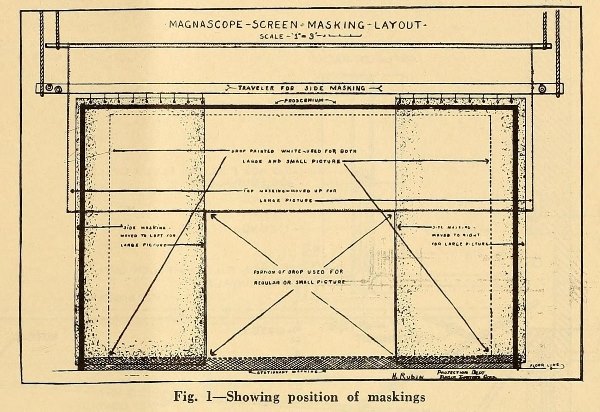 Old Ironsides—the 1926 super-production, helmed by one of Paramount’s most important directors, James Cruze—isn’t much shown these days. It’s never been released on DVD or Blu-ray, though it was briefly available on VHS in the late 1980s, when Paramount mined its silent library for a 75th anniversary promotion. If you’ve come across Old Ironsides at all, it’s likely been as a footnote in a film history textbook, duly credited as the film that introduced Magnascope—a widescreen projection process developed by Lorenzo Del Riccio that is itself a footnote in the development of Cinerama and CinemaScope.
Old Ironsides—the 1926 super-production, helmed by one of Paramount’s most important directors, James Cruze—isn’t much shown these days. It’s never been released on DVD or Blu-ray, though it was briefly available on VHS in the late 1980s, when Paramount mined its silent library for a 75th anniversary promotion. If you’ve come across Old Ironsides at all, it’s likely been as a footnote in a film history textbook, duly credited as the film that introduced Magnascope—a widescreen projection process developed by Lorenzo Del Riccio that is itself a footnote in the development of Cinerama and CinemaScope.
But should we dismiss Magnascope so quickly? Yes, we can draw an evolutionary line between Magnascope and the more durable widescreen processes. We can also readily glimpse the Magnascope concept in today’s IMAX presentations. But Magnascope’s true legacy is something else, situated between chintzy striving and earnest grandeur, between what filmmakers thought they were making and what projectionists made instead.
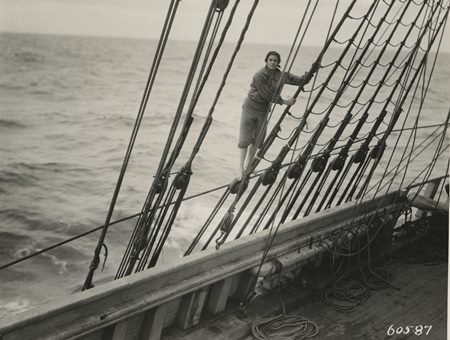 The process itself was relatively simple. For select scenes, the projectionist would use a short focal length ‘Magnascope’ lens to substantially enlarge the 1.33:1 image, cropping away some portion along the top and bottom of the frame. The Magnascope image would fill the theater’s proscenium, using an enlarged screen that was about four times bigger than the regular one. (Even in picture palaces that sat thousands, screens were typically no wider than 20 or 22 feet before Magnascope.) Magnascope had no fixed aspect ratio—a theater would have shown the Magnascope scenes as wide as its proscenium would permit, probably somewhere around 1.63:1 to judge by contemporary sketches. While the projector switched to Magnascope, stagehands would slowly open up the screen masking, which gave the illusion of a gradually enlarging image.
The process itself was relatively simple. For select scenes, the projectionist would use a short focal length ‘Magnascope’ lens to substantially enlarge the 1.33:1 image, cropping away some portion along the top and bottom of the frame. The Magnascope image would fill the theater’s proscenium, using an enlarged screen that was about four times bigger than the regular one. (Even in picture palaces that sat thousands, screens were typically no wider than 20 or 22 feet before Magnascope.) Magnascope had no fixed aspect ratio—a theater would have shown the Magnascope scenes as wide as its proscenium would permit, probably somewhere around 1.63:1 to judge by contemporary sketches. While the projector switched to Magnascope, stagehands would slowly open up the screen masking, which gave the illusion of a gradually enlarging image.
Magnascope’s initial rollout was shaky, though this was retroactively explained away as a deliberate ‘soft open.’ According to Paramount’s Jesse Lasky, the Magnacope process was barely promoted, even though the studio had judged the effect impactful enough to reedit the picture:
I coined the name ‘Magnascope’ on the spot [after a demonstration using scenes from Old Ironsides], and eagerly authorized the necessary expenditure for a big screen in order to project the sea battle in overwhelming magnitude. We recut the picture to make the most of these scenes. Dr. Hugo Reisenfeld, arranger of the musical score and orchestra leader, stepped up the tempo and volume of the music as the picture suddenly grew gigantic before the startled eyes of the first-night audience. There hadn’t been time to advertise the big-screen innovation before the premiere, and everyone was so taken by surprise that all stood up and cheered wildly. The New York Times broke precedent the next morning by running its review of the picture on the front page.
Compared to what would come later, Magnascope was not an especially radical departure from contemporary exhibition practices. It did not require accommodating a new film gauge (as Fox’s 70mm Grandeur system would) or redesigned perforations and sprockets (the “Fox holes” of early CinemaScope). It certainly demanded nothing on the scale of the Cinerama’s military-level synchronization. There were no special Magnascope prints taking up shelf space at a film depot, just ordinary 35mm prints transformed into Magnascope spectacle by enterprising showmen. All existing booth equipment and projectors could still be used with Magnascope. The new lens was the main component. Harry Rubin, projection supervisor for Paramount’s Publix Theatres Corp. and Magnascope’s biggest booster, additionally suggested outfitting Magnascope projectors with a new intermittent and shorter shutter blades to maximize the amount of available light on screen.
Rubin was conspicuously modest about the format, likely hoping to reassure tight-fisted exhibitors that Magnascope was no great extravagance. Writing up the development in a 1928 issue of The Motion Picture Projectionist, Rubin demurred:
It should be clearly understood that no claim is made that any new engineering principle is involved or that any radical mechanical advance has been made in the development of the Magnascope. It was, however, a striking and quite ingenious novelty, proved highly successful for entertainment purposes, and it attracted more attention than anything of a similar nature for many years . . . .
It involved no great initial expense in its development or any additional cost of operation.
Improvements intended to secure similar effects are of course being used now; but with the equipment devised by us, entirely satisfactory results were secured on an economical basis. This is, of course, always desirable in working up novelties or experiments of this nature.
It’s easy to diminish the importance of Magnascope, not least because its primary cheerleader affected only a stage whisper. Magnascope was used occasionally, almost lackadaisically, to heighten the basest spectacles. It was not, in today’s parlance, a disruptive technology; it was always meant as a supplement to conventional 35mm projection, not a replacement. And because it was used in a limited number of theaters in select markets, it was never the focus of a national advertising campaign. Unlike its widescreen successors, the Magnascope name was never emblazoned on a movie poster or emphasized in a studio pressbook.
The spotty advertising is, in fact, the major impediment to studying Magnascope. How many officially sanctioned Magnascope releases were there? A handful of Paramount titles from 1926-1927—Old Ironsides, Chang, and Wings—are consistently cited as Magnascope films, but the record gets hazier after that. It’s generally thought to have petered out after the short-lived vogue for genuine wide-film processes in 1930, and then returned in some fashion in the late 1940s, with Portrait of Jennie and a few other titles. Did the theaters just forget about this equipment and chalk it up to a failed experiment dreamt up in the front office?
No, and here’s where Magnascope gets even more interesting. Although Magnascope began as an exhibition gimmick closely associated with one studio and its affiliated theater chain, the concept ultimately worked more like a loosely-controlled franchise operation. Once a venue acquired Magnascope (or Magnascope-esque) equipment, which was available from a variety of theatrical supply dealers, they had considerable leeway in using it as they saw fit. One boilerplate overview of Magnascope aimed at theater managers, which appeared in several trade publications variously attributed to Harry Rubin or F.H. Richardson, is illuminating:
With the magnascope screen the manager should carefully select the weekly subjects or portions of his feature for such magnascope use. The opening of magnascope creates the illusion of gradual enlargement and, therefore, magnascope should never begin with a title—with this exception—when the draw curtains are opened on a magnascope screen as at the beginning of a subject. When going from small picture to magnascope an appropriate scene must be chosen which conveys spaciousness and secures the best results.
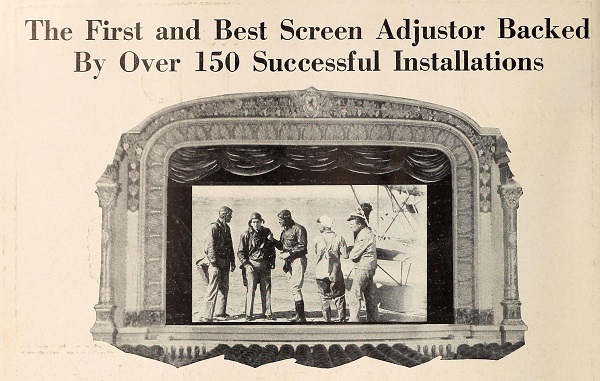 It appears that Paramount loosened the leash sometime after Wings, according individual exhibitors a strong degree of autonomy in deploying Magnascope at their own aesthetic discretion.
It appears that Paramount loosened the leash sometime after Wings, according individual exhibitors a strong degree of autonomy in deploying Magnascope at their own aesthetic discretion.
This is an important corrective to our usual, top-down view of film history, forever striving to respect the intent of the director or the producer or the studio chief. When it comes to Magnascope, there is not a single, correct version of the film: what the original audience saw in Chicago differed from what their contemporaries saw in Atlanta. Magnascope was simply one variable element of the filmgoing experience, alongside the exhibitor’s choice of musical accompaniment, projection speed, or the line-up of short subjects. It would be more convenient for us—as viewers, as fans, as scholars—to sanction one version of a given film, but we must also reckon with the fact that many variant experiences were equally valid to the film’s original audience.
The historical record strongly validates this approach. The trade papers are full of anecdotes about individual venues trying some combination of feature film and exhibition gimmick, including Magnascope. The 19 Dec 1931 edition of the Motion Picture Herald carried a notice that E.E. Collins, manager of Houston’s Metropolitan Theatre, had experimented with a Magnascope presentation of Eddie Cantor’s Palmy Days that was
received so enthusiastically by patrons that the idea was passed along and used by Publix houses in Dallas and San Antonio . . . .
In the ‘Bend Down Sister’ number song by Charlotte Greenwood, the [Magnascope] screen was used with a lavender gelatine tint in a frame in front of the lens, thus tinting the entire screen and giving it added production values. Later in the picture, when Eddie Cantor sang ‘There’s Nothing Too Good for My Baby,’ the magnascope was again used but in addition to the lavender gelatine, a yellow or straw-colored gelatine was used on the F-7. In other words, the picture was shown on a magnascope size with a purple tint from the machine plus a straw tint from the F-7.
In line with Collin’ statement that the use of the above greatly enhanced entertainment values of certain scenes, we are passing the idea along for others to try out and will be interested to learn if this also meets with successful reception at other theatres
In the June 1932 issue of International Projectionist, the ever-cranky editorialists complained that “Magnascope (enlarged screen) is old stuff. Yet, this is the one projection ‘stunt’ that always draws the ‘Ohs’ and ‘Ahs’ from any audience.” They went on to concede that two Broadway houses had discovered that The Doomed Battalion “is enhanced in entertainment value by about 25 per cent (in our estimation), through clever employment of Magnascope.”
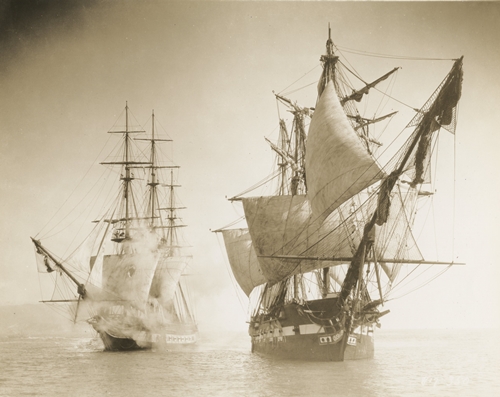 These ‘enhancements’ continued longer than some might suspect. In 1938, the Motion Picture Herald reported very positive reaction to a Magnascoped climax of The Hurricane at the Rivoli—and suggested that exhibitors try the same stunt for In Old Chicago’s fiery tumult as well.
These ‘enhancements’ continued longer than some might suspect. In 1938, the Motion Picture Herald reported very positive reaction to a Magnascoped climax of The Hurricane at the Rivoli—and suggested that exhibitors try the same stunt for In Old Chicago’s fiery tumult as well.
Alas, there’s no comprehensive repository of information about Magnascope—no corporate archive, no central ledger. Since Magnascope was very much at the discretion of individual exhibitors, documenting its real history requires us to muck around in the weeds. Anthony L’Abbate, Preservation Officer at the George Eastman Museum, should be familiar to readers of this blog from his work reconstructing the trajectory of the tinted talkie. His efforts to trace Magnascope follow the same methodology: searching through digitized newspaper archives to find theater ads touting the process in conjunction with the run of a given film or reviews that mention a specific sequence in a recent release receiving the Magnascope treatment. (In compiling this article, the Lantern search platform has been equally valuable for culling through the many historical trade publications found at the Media History Digital Library.)
As with tinted talkies, it’s difficult to compile a definitive list of Magnascope presentations—the effect was just special enough to receive notice one week and just commonplace enough to be old news the next. Still, L’Abbate’s list now exceeds forty titles, and includes some real surprises: musical numbers in Glorifying the American Girl (1929) were shown in Magnascope at the Paramount Theatre, as were three numbers from The Show of Shows (1929) at the Winter Garden; the caribou hunt in The Silent Enemy (1930) at the Criterion; the entirety of Hell’s Heroes (1930) at the Colony; portions of musical numbers in 42nd Street (1933) at the Strand; the titular charge in The Charge of the Light Brigade (1936) at the Paramount in Brooklyn.
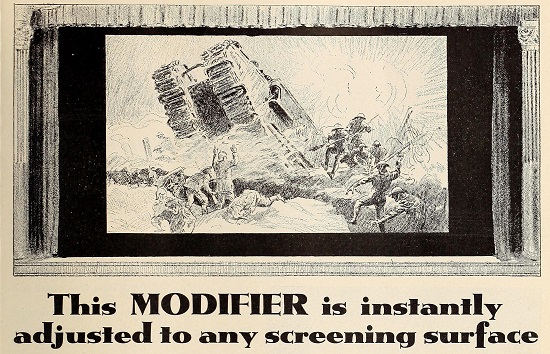 And that’s just New York. The battle sequences in All Quiet on the Western Front (1930) received Magnascope treatment in Los Angeles and the red-tinted hell centerpiece of Dante’s Inferno (1935) got Magnascoped in Philadelphia. The Mayfair in Asbury Park, New Jersey, experimented with a Disney cartoon, Mickey’s Garden (1935), and found audiences so enamored that they announced all future Mickey Mouse cartoons would be shown in Magnascope, too. (Did Disney let them? Did Disney even know?)
And that’s just New York. The battle sequences in All Quiet on the Western Front (1930) received Magnascope treatment in Los Angeles and the red-tinted hell centerpiece of Dante’s Inferno (1935) got Magnascoped in Philadelphia. The Mayfair in Asbury Park, New Jersey, experimented with a Disney cartoon, Mickey’s Garden (1935), and found audiences so enamored that they announced all future Mickey Mouse cartoons would be shown in Magnascope, too. (Did Disney let them? Did Disney even know?)
And then, of course, there’s the fact that not everyone who used the Magnascope concept credited it under that name. The Eastman Theatre in Rochester, New York, experimented with the same idea nearly two years before the Old Ironsides premiere, with the stampede sequence in North of 36 presented on a 30’ x 40’ screen (a substantial increase over that house’s standard 17’ x 21’ screen) in February 1925. The same theater screened enlarged versions of The Thundering Herd and The Black Pirate well before the Old Ironsides premiere.
The Eastman Theatre’s projectionists, Lewis M. Townsend and Wm. W. Hennessy, set down these facts in the Transactions of the Society of Motion Picture Engineers, but not to settle a score. They outlined a number of other harebrained projection gimmicks they had developed and implored their peers to experiment likewise:
We fully realize that some of the stunts have been crude and that engineers can probably think of many ways to improve upon them . . . . Motion pictures should be able to stand on their own feet without the addition of spectacular reviews, expensive vaudeville acts and what not—to draw a crowd. When theaters are compelled to resort to this it means there is not enough element of newness and entertainment in the pictures. If the picture is lacking in these things we strive to do something unusual to pep it up, and sometimes we succeed . . . .
Let’s not get in a rut. There are many good projectionists throughout the country. Give any of them something out of the ordinary to do, then back him up. He will put it over. Many more dollars will be reaped through the box office than will have to be paid him for the extra work or for the expense involved in a little additional equipment.
Good advice—and perhaps even more relevant now, when projectionists are marginalized or considered expendable altogether. The age of Magnascope has only begun.

The Northwest Chicago Film Society will be screening Old Ironsides in 35mm on Wednesday, February 3. The presentation will include a recreation of the Magnascope process and live organ accompaniment from Jay Warren. Print courtesy of the Library of Congress. More information here.
Old Ironsides stills courtesy of the Museum of Modern Art / Film Stills Archive. Magnascope images courtesy of the Media History Digital Library.
Further Reading
- John Belton. Widescreen Cinema. Cambridge, Mass.: Harvard University Press, 1992.
- Kevin Brownlow. The War, the West, and the Wilderness. New York: Alfred A. Knopf, 1979.
- Richard Koszarski. An Evening’s Entertainment: The Age of the Silent Feature Picture, 1915 – 1928. History of the American Cinema, Vol. 3. New York: Charles Scribner’s Sons, 1990.
- James L. Limbacher. Four Aspects of the Film. New York: Brussel & Brussel, 1968.
